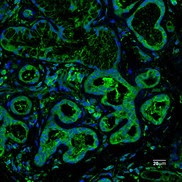Scientists Find New Pain-Suppression Center in the Brain

Researchers identified a group of neurons in mice that blunt pain by dampening the activity of multiple pain-processing regions of the brain. The neurons could be promising targets for new non-addictive therapies for chronic pain.
|
A Microbial World on the Top of Your Tongue

Scientists used a new technique to visualize fluorescently labeled bacteria in intact biofilms scraped from the tongues of 21 healthy human volunteers. They found that three types of note—Actinomyces, Rothia, and Streptococcus—were present in all participants. The prominence of these microbes suggests they may be important in maintaining oral and overall health.
|
Targeted Approach to Sjögren’s Syndrome

Using small-molecule inhibitors that act on cell signaling, NIDCR researchers restored salivary function in mouse models of Sjögren’s syndrome. The scientists’ target was a protein called BMP6, a possible driver of salivary gland dysfunction in this autoimmune disease.
|
Cellular Therapy Could Soothe Sarcoidosis

NIH’s I Am Intramural Blog reports on a study by NIDCR’s Eva Mezey, MD, PhD, who found that cells from bone marrow could be used to calm out-of-control immune cells that harm the lungs of patients with an inflammatory disease called sarcoidosis. Future studies will be needed to determine how a cell-based treatment for sarcoidosis might be delivered into patients’ lungs.
|
Researchers Develop More Durable Dental Materials
 |
Researchers have developed fillings that are twice as strong and longer lasting than those now used in dental clinics. The next step is to make those fillings more resistant to cavity-causing bacteria without harming the beneficial species that live in the mouth.
|






















.png)











No hay comentarios:
Publicar un comentario